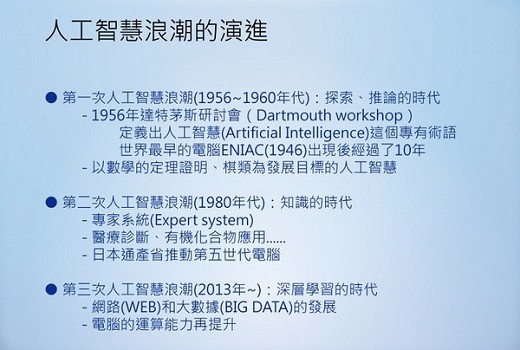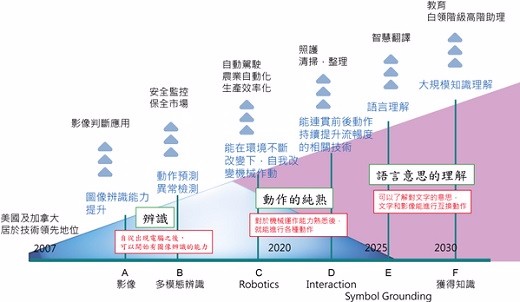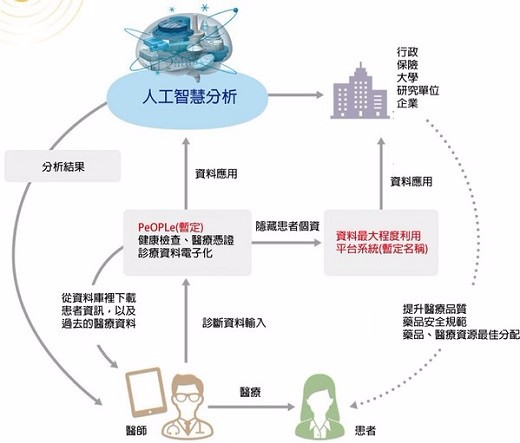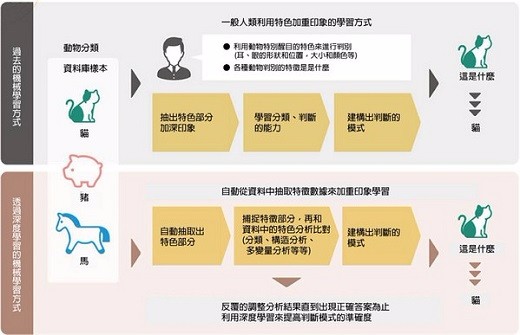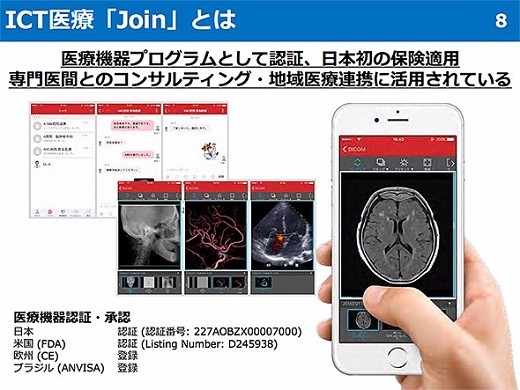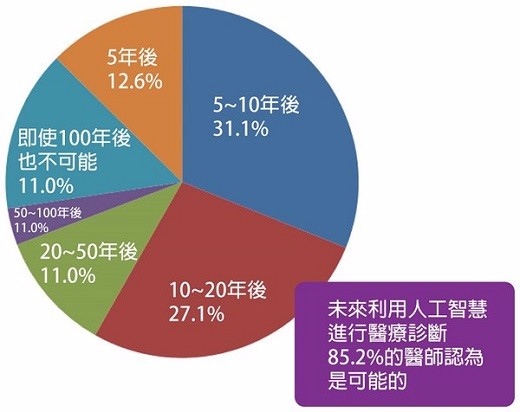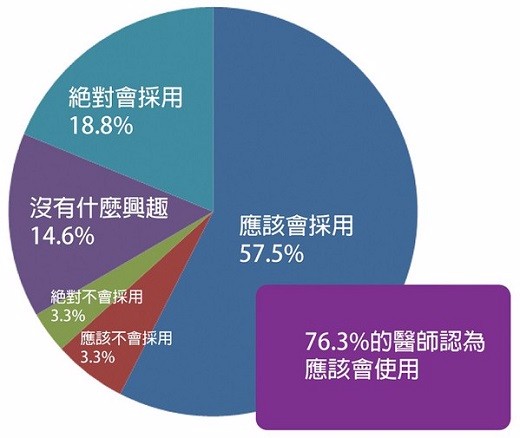From the early 1960s, the academic circles began to carry out research on artificial intelligence, and the third wave of artificial intelligence brought about by the current concept of machine learning and deep learning. For the medical field, in the early 1970s, artificial intelligence has been applied to various tests, such as the discovery of infectious blood diseases of patients based on the results of blood tests, and extending the outpatients to determine which antibiotics to use. Successful treatment greatly improves the accuracy of the judgment of infectious diseases compared to the rules of thumb used in the past. Through the power of artificial intelligence technology, inspection can be completed in a flash Until recently, the ability to deepen learning techniques has greatly improved the accuracy of image recognition, for example, through X-ray photography, Computed Tomography, and Magnetic Resonance Imaging. As well as a test device such as a cell test (Cytodiagnosi), it is possible to discover the abnormal state of the body from the findings of ulceration and the result of tumor enlargement. These inspection processes and discoveries have taken more than 10 days from the past, and through the power of artificial intelligence technology, it can be completed in an instant. I believe that it is foreseeable that in the near future, there will be considerable medical changes in the medical field (Figure 1, Figure 2, Figure 3). For the diagnosis of diseases, in the simpler aspect, it has been possible to perform artificial intelligence assisted by similar suggestions, for example, by inputting a diagnosis and examination result in a device having medical artificial intelligence. Suggested content similar to the diagnosis. Figure 1: From the early 1960s, academic circles began research on artificial intelligence. Figure 2: With the advancement of identification technology, there will be a large-scale medical revolution in the medical field (A) Figure 3: With the advancement of identification technology, medical reforms in the medical field will also appear (B) Like humans, artificial intelligence in the medical field also requires a certain degree of learning before it can produce the ability to judge things. Using the technology of learning, the results of the lesion can be found in the medical images taken, plus the patient's After the symptoms and genomic data, the preliminary diagnosis results can be analyzed. Japan promotes the application of artificial intelligence in the medical field through policy plans Therefore, for the application of artificial intelligence in the medical field, Japan has also started to promote it programmatically from the government. In November 2016, at the 2nd Future Investment Conference held by the Japanese government, Prime Minister Shinzo Abe made a clear declaration. Big Data and artificial intelligence will be used to the greatest extent in prevention, health management, and telemedicine to achieve high medical quality and introduce artificial intelligence into the Japanese medical system, and the Ministry of Health, Labor and Welfare of Japan has also begun. We embarked on a series of related policies to respond to the advent of the artificial intelligence medical era, including the revision of medical expenses, incentives for artificial intelligence medical treatment, etc., and it is expected that the artificial intelligence medical system will be fully implemented and promoted by 2020. In order to achieve a higher level of application of artificial intelligence in the medical field, the construction of a highly complete and secure database is absolutely necessary. In this regard, the Japanese government has begun to integrate and establish, including electronic medical record cards, health check data, medical care, and care. The receipt system data such as the receipt voucher data is the first step to provide better medical quality under the framework of the next-generation health management system (Figure 4). Figure 4: Conceptual map of the patient information data database being planned by the Japanese government The artificial intelligence medical management system called PeOPLe has begun to integrate and preserve the medical diagnosis records of every patient in each medical institution in Japan, and has given each patient identification number (medical ID), in addition to facilitating the preservation and management of medical data. In addition, the data of patients in different medical units are also stored and managed in a unified manner. In the future, medical personnel can read the patient's past complete medical data and various inspection reports from the database. In terms of medical personnel, in the future, PeOPLe will also record the diagnosis and treatment information of each patient. At the same time, it can also be used as an examination, diagnosis and treatment while the patient is returning to the clinic through the ability of artificial intelligence technology. Medical support, advice and various warning reminders can be provided to medical personnel. However, after informatization, in addition to saving unnecessary and wasteful inspections, and the optimal allocation of medical resources, and through anonymized medical data, various academic units are provided for more advanced medical research. Toshihiko Takeda, Director of the Department of Medicine and Health Affairs of the Ministry of Health, Labour and Welfare, said that in the future health management system, under such a concept, data such as medical care and care will be networked, and as part of big data, in addition to reducing the burden on medical personnel. In addition, through the big data database, with the assistance of artificial intelligence technology, the next generation of medical development planning for each region can be carried out, so that patients in various regions can get better medical services. Constantly repeating the calculations to achieve the ability to quickly increase the height of judgment In the construction of the medical service system in this era, the most important thing is the technical strength of artificial intelligence, but what kind of structural changes will artificial intelligence be carried out here? Initially, the computer system only has to input and store data such as images and texts, and further can perform simple signal collection, sorting, identification and analysis. With the addition of artificial intelligence, these signal data can be simultaneously compared and characterized, and then judged for these characteristic text images. Just like the analysis of the images taken by the patient through various inspection devices, and then further obtaining the results of the diagnosis and judgment, and then comparing with the sample data in the database, according to the default rules to make each Kind of examination report. In the past, it was necessary to collect various medical information obtained and provide a computer or instrument with preliminary artificial intelligence for comparison analysis by manual input. However, with the rapid development of computer computing power, it is possible to carry out more complicated and cumbersome program calculations. Such changes can be made from the simple correspondence of "If it is A, then it will evolve to B". Going to the multi-level judgment and analysis of "in the case of A, if B is out, it may evolve into C", let the artificial intelligence technology progress to the stage of "deep learning" by itself, and then no need to rely on labor for preliminary Or after the comparison of data input work, with the deep learning ability of artificial intelligence, continuous repeated calculations, to achieve automatic data identification, and quickly increase the ability to judge highly. Figure 5: Artificial intelligence conducts self-learning regularly through a mechanical approach. In the field of artificial intelligence for medical learning, the basis of individual judgment is the same as ordinary people, no different. The Bioinformatics Department of the Keio University of Science and Technology, which has been investing in artificial intelligence development for many years? Professor Kang Wen said that doctors extracted important key messages from the patient's consultation results, as a preliminary and extensive judgment, and then used the results to identify the patient's pathology. At this time, the doctor must also carry out repeated thinking and verification based on past learning knowledge and experience to improve accuracy and obtain correct diagnosis results. The artificial intelligence medical mechanism is the same, but the big difference is that artificial intelligence corrects various coefficient results through complex calculations, and iteratively repeats fine adjustments to obtain the final result. Introducing artificial intelligence into emergency medical treatment to improve the chance of first aid success Traditionally, emergency medical care is essentially a medical team and time to compete. After the introduction of technology, emergency medical care has added the assistance of smart phone APP and artificial intelligence. At the Tzuhui Medical University in Tokyo, Japan, the brain neurosurgeon Takao Yoji, who is a professor at the Advanced Medical Information Technology Research Seminar, has been responsible for the task of using mobile APP and artificial intelligence to assist emergency medical treatment since November 2016. In 2017, the clinical application experiment was officially started, and it is expected to be officially introduced into the emergency site in 2018. In 2015, Dr. Takao Yoji was already at the Cihui Hui Medical University in Tokyo, Japan, and had more than 3,000 iPHONE import experience with this function, and information on medical information. When the program was officially launched in 2016, in addition to the hospital's main body, the company Allm joined the company to develop a smart phone app, and integrated artificial intelligence technology, called JOIN. JOIN's architecture is designed to enable rapid and effective communication and data analysis among several medical stakeholders, and to enable simultaneous access to several medical stakeholders, including operating rooms and emergency rooms, such as X-ray photography and computed tomography. Or magnetic resonance imaging, medical photography, electrocardiogram and other physical test results and data. Figure 6: Using emergency mobile phone APP and artificial intelligence to assist emergency medical treatment In fact, the ambulance personnel at the emergency site are quite difficult to correctly grasp the patient's injury or health condition, and are unambiguously communicated to the medical personnel who follow the emergency. The plan to use the smart phone APP and artificial intelligence to assist emergency medical treatment is to use the smart phone APP and artificial intelligence to enable the back-end emergency team to get the patient's condition early in the emergency rescue and delivery process, and shorten the initial arrival. The time of injury detection is to achieve the goal of improving the success rate of first aid and alleviating various health sequelae. This first-aid architecture uses artificial intelligence to conduct consultations and life-sense sensing, analyzes the information obtained, and performs a Triage. Based on the results of this analysis, when a medical unit receives an emergency patient, it is sufficient to pre-establish a first-aid plan and to select a patient to be transported. For example, in patients with acute cerebrovascular disease, emergency ambulance personnel may be pre-related to simple emergency medical treatment in the event of symptoms. For example, in patients with cerebral embolism, tPA can be administered intravenously within 3 hours after the onset of symptoms. The use of such drugs must rely on the cooperation of the medical team to race against time to rescue brain cells. Intravascular treatment was performed with a thrombectomy device within 8 hours to minimize stroke sequelae. And these pictures, data, various actions, and communication between medical staff can be carried out through the JOIN app in the mobile phone. Furthermore, Dr. Takao Yoji not only asked JOIN for the emergency and consultation of patients during emergency delivery, but also integrated artificial intelligence to complete the Cloud ER system. Initially, brain and cardiovascular patients will be the first aid targets. Improve the success rate of first aid and reduce sequelae through the Cloud ER system. There are two broad types of data analysis for artificial intelligence used in the "Cloud ER" system. The first category is for patients to wear medical electronic wristbands that measure vital signs such as heart, blood pressure, and electrocardiogram. The second category is to collect and organize the patient's disease data through the APP in the smartphone. When the medical institution that is scheduled to receive the patient also obtains the data of the disease from the JOIN and Cloud ER systems, the patient's first aid plan can be formulated, and the relevant first aid equipment can be prepared. On the other hand, the person in charge of the transportation can be instructed at the same time. After the necessary first aid measures are taken and the patient is delivered to the medical institution, the most appropriate emergency medical care can be obtained immediately. Not all medical personnel are willing to accept the advent of the artificial intelligence medical era Although the introduction of artificial intelligence into the medical system, through the promotion of the government and the technical integration of various industries, it seems to be an inevitable trend, but for today's medical system and medical personnel, it is still necessary to face an inevitable adaptation period. . In fact, through the analysis of professional media interviews in Japan, it can be found that not all medical personnel are willing to accept the advent of the artificial intelligence medical era, and even some medical activities will be replaced by artificial intelligence systems or robots. Deeply angered some of the medical staff. According to the survey, about 85.2% of current Japanese physicians believe that medical assistance will be achieved through artificial intelligence in the next 100 years. Less than 15% of physicians believe that even after another 100 years, artificial intelligence can't replace humans for medical behavior. As for the use of artificial intelligence products as medical aids, nearly 19% of physicians still reject or even introduce artificial intelligence medical products (Figure 7 and Figure 8). Figure 7: Proportion of physicians predicting the introduction of artificial intelligence into medical time Figure 8: Proportion of physicians who will use artificial intelligence to assist with medical behavior As far as opinions are concerned, most physicians who receive artificial intelligence medical care believe that artificial intelligence medical treatment can achieve re-confirmation function to prevent human negligence, and can provide diagnostic assistance, prevent misdiagnosis, and shorten the time of diagnosis, even through The power of artificial intelligence to reinforce the skills and knowledge of its unskilled fields. Of course, not all physicians are so positive about artificial intelligence. For the physician, the heaviest burden is the need to bear the “responsibility to the patientâ€. Therefore, the most direct response is that when misdiagnosis occurs, which aspect of the burden is required? Some doctors believe that because of the inability to take responsibility for artificial machinery, it is absolutely impossible to carry out the work of confirming the diagnosis. At most, it can only provide reference data for the doctor to make a diagnosis. Because on the diagnosis, whether it is a chronic patient or an object that needs to be first aided, there are too many changes in the medical behavior, and it still needs to rely on the experience of the physician. In this respect, artificial intelligence is absolutely impossible. . Therefore, it is good for the robot to measure the data of the vital signs. In other aspects, it is necessary to give it to an experienced physician, and it is necessary to pay attention to the medical experience and ability value of the physician for many years. Organic Alfalfa Juice Green Powder Organic Alfalfa Juice Green Powder,Alfalfa Grass Powder,Alfalfa Grass Juice Powder,Organic Alfalfa Juice Powder Hengshui Shanzhi Health Drink Co., Ltd , https://www.grasspowder-sz.com